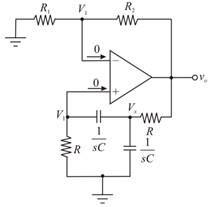
Concept explainers
The loop gain, the frequency of the oscillation and the required ratio of the resistance to obtain the oscillation for the given function.
Answer to Problem 15.40P
Explanation of Solution
Given:
The circuit is given as:

For the ideal operation amplifier, the inverting and non-inverting terminal currents should be 0. The inverting and non inverting node voltages should be equal by the virtual ground concept.
Redrawing the above circuit:

Applying Kirchhoff s current law at node
Hence,
Applying Kirchhoff s current law at non-inverting node:
Substituting
Therefore, the feed-back gain is given as:
Applying Kirchhoff s current law at inverting node:
Therefore,
The loop gain is known as the multiplication of the amplifier gain and the feedback transfer function gain as shown below:
Therefore,
The transfer function is
Put
Therefore,
For frequency oscillation the real part should be 0:
Therefore,
The frequency oscillation is
For the oscillation, the imaginary part is equal to 1:
Therefore,
Want to see more full solutions like this?
Chapter 15 Solutions
Microelectronics: Circuit Analysis and Design
- What is active low pass filter?Explain it's impact and application in engineering problem.arrow_forwardIn Steady-State Operation o f Buck DC-DC Converter Explain how the switching frequency component is eliminated by the output filter network.arrow_forwardWhat is the function of a filter? What is a typical application? What is an active filter?arrow_forward
- 6. Refer to the RC Phase-shift Oscillator below. A Vin R₁ + Rf 6.a. Derive the feedback factor formula for this circuit. 6.b. Draw the output waveform. C C mm C Vout wwwwwarrow_forward#has an input Q/The buck-boost regulator gu voltage of Vs = 12V. The duty cycle = 0.25 and the switching frequency is 25 KHZ. The inductance L = 150 μul and filter Capacitance C= 220 μf. The average load Current Ia = 1.25A. Determine (a) the average output voltage, Va (b) the peak-to-peak output voltage ripple, Avc (c) the peak-to-peak ripple current of inductor, AI (d) the peak Current of the transis () the critical values of L and C min. min.arrow_forwardFor the filter in the Figure shown: (a) What is the critical frequency? (b) Looking at the critical frequency formula, how would you increase the critical frequency value? (c) What is the voltage gain? (d) Looking at the voltage gain formula, how would you increase the gain?arrow_forward
- A clamping circuit has to have an independent source, a diode, a resistor, and a capacitor. To keep a constant voltage on the capacitor over the period of the input, the RC time constant must be large. A design rule of thumb is to make the RC time constant at least five times the half period of the input signal. Why do we need to make the RC time constant at least five times the half period of the input signal greater? Is having a 2, 3, or 4 times RC time constant, not enough?arrow_forwardA sinusoidal signal of 2 kHz frequency is applied at the input of a delta modulator with a step size of 0.1 volt. The sampling rate of the delta modulator is 20000 samples per second. What will be the maximum amplitude of the sinusoidal signal if there is no slope overload distortion?arrow_forwardFM modulated signal is demodulated using: Select one: O a. Discriminator O b. Discriminator followed by integrator Oc. Costas PLL O d. Carrier reinsertion methodarrow_forward
- Hononta (Vj Ais M QUESTION (1) pressure signal from a force transducer is given as under. Analyze it in terms of harmonics, amplitude, circular frequency, cyclic frequency, time period and phase. A. P=15 sin(20m + +12 sin(40t-)+10sin(60t +)+8sin(100zt +")+5sin(140nt -"). +3sin(180) Pa %3Darrow_forwardDiscuss the disadvantages of increasing the order of the filter.arrow_forwardSignal and system problem plz explain every step how do this steparrow_forward
 Electricity for Refrigeration, Heating, and Air C...Mechanical EngineeringISBN:9781337399128Author:Russell E. SmithPublisher:Cengage Learning
Electricity for Refrigeration, Heating, and Air C...Mechanical EngineeringISBN:9781337399128Author:Russell E. SmithPublisher:Cengage Learning
